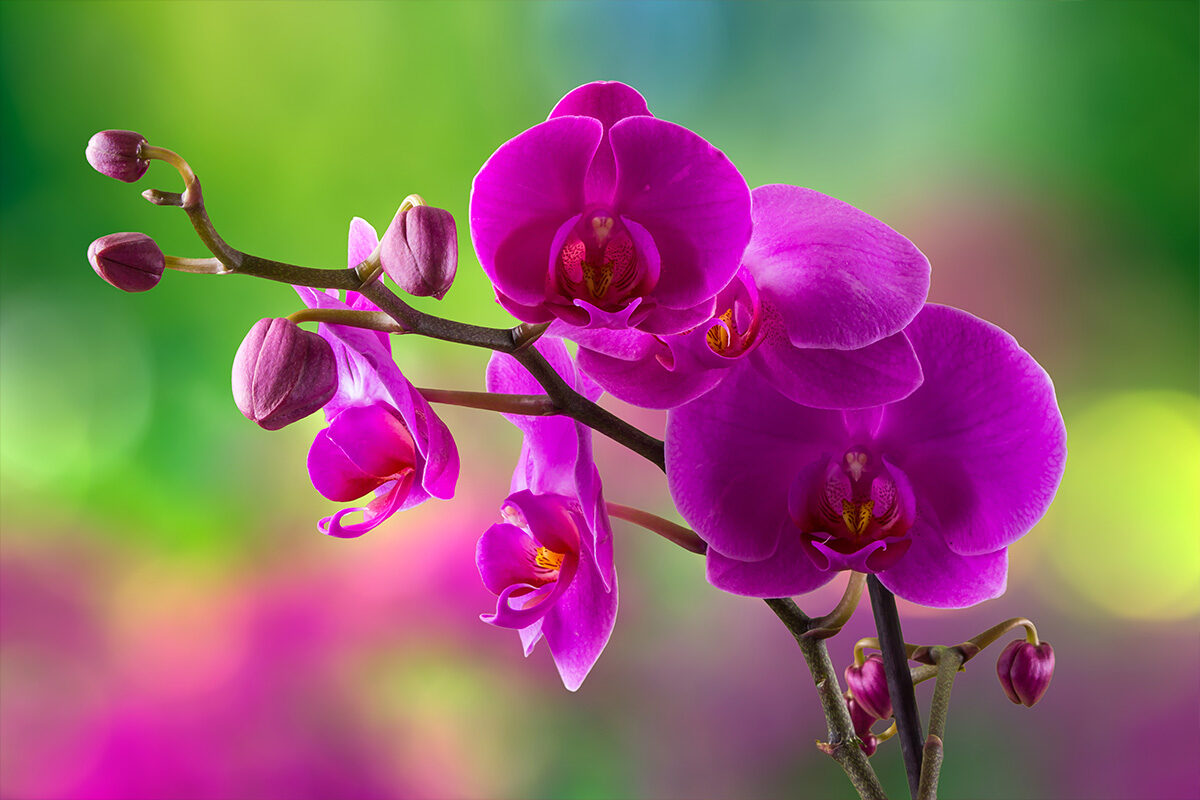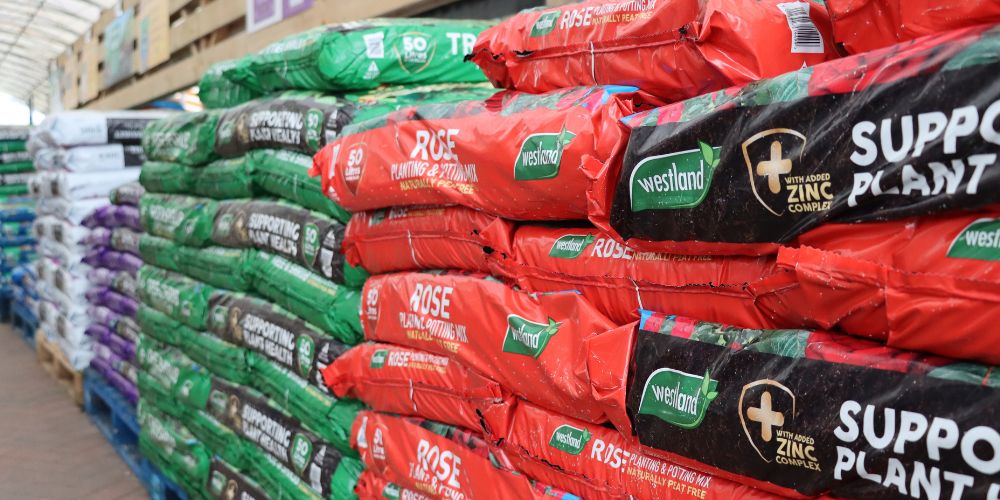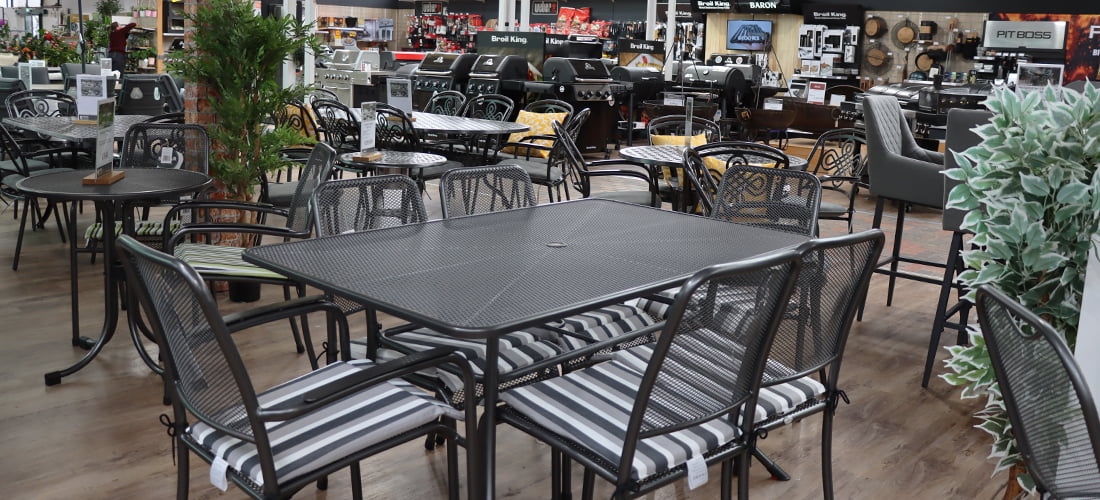CULTURAL NOTES
Prized for their exotic, long-lasting flowers, orchids are usually regarded as difficult plants that are suitable only for growing under controlled greenhouse conditions, but several species can be grown successfully in the home.
Some species of orchid are terrestrial, growing in soil, but most of those grown as indoor plants are epiphytic and in the wild grow on trees or sometimes rocks. In addition to roots at the base, these orchids usually have aerial roots and need a special compost and container if they are to do well in the home. There are two types of epiphytic orchid: monopodial that produce a single stem from the roots at the base, and sympodial that have many stems arising from a horizontal rhizome. The latter have pseudo bulbs variously shaped swollen stem bases that look like bulbs and store water and food for the plant.
Among the best orchids for growing in the home are epiphytic cymbidiums, cattleyas, dendrobiums, miltonias, and odontoglossums. Phalaenopsis are the easiest to grow.
Many of the varieties mentioned below can be viewed on our Plant Finder.
PHALAENOPSIS
The moth orchid makes an ideal plant for a centrally heated home. The flowers may look delicate, but they are quite robust often remaining in good condition for over three months. One stem can carry nine or more flowers and a plant may have more than one stem, depending on age. Flower spikes may appear any season, and this orchid usually re-flowers within the year.
Temperature: It grows best in daytime temperatures above 20°C with nights not below 16°C. Avoid placing the plant too close to a radiator or in a draught.
Light: Moth orchids like good light but will also tolerate light shade during the growing season, they should not be kept in full sun or they will scorch. Keep them in a well-lit position during the winter months.
Water: Phalaenopsis like plenty of water but don’t like damp situations so a very open mixture of compost is required to grow them successfully. Water once every 10-14 days depending on temperature.
Humidity: The higher the temperature, the higher the humidity required. In a dry climate, stand the plant on a moist gravel tray and make sure the base of the pot is above the water level. Gently misting the plants in the early morning also helps.
Feeding: Include orchid fertiliser in three out of four waterings.
Re-potting: Repot every other year in spring, but not when in flower.
After flowering: Cut the stem back to just above a node, leaving around 20cm of stem. Often a secondary spike, or flower stem, is produced from this node.
CATTLEYA
Cattleyas are among the most flamboyant of orchids and are often used as corsages. They are also known as chocolate box orchids. Their flowers can last up to four weeks on the plant. Epiphytic roots can be seen developing above the growing medium.
Temperature: Daytime temperatures above 20°C, with nights not below 14°C. Avoid placing too close to a radiator or in a draught.
Light: These plants thrive in good light but not direct sun. They will tolerate light shade during the summer months but none during the winter.
Water: Water frequently when growing, but allow to dry out a little between waterings. Water thoroughly from the top and allow it to drain. Reduce the frequency of watering as the temperature drops and light levels decrease.
Humidity: Good humidity is the key to success. The higher the temperature the higher the required humidity. In a dry atmosphere, stand the plant on a moist gravel tray to create a microclimate and assist growth.
Feeding: Include orchid fertiliser in three out of four waterings.
Re-potting: Use a coarse, bark-based compost, such as a mix of 3 parts medium grade bark chippings, 1 part perlite and 1 part fine charcoal. Repot only in spring and every two to three years.
After flowering: Remove dead flowers and sheaths.
DENDROBIUM
Dendrobiums bear groups of flowers, often fragrant, on short stalks, which grow from tall, usually stem-like pseudo bulbs. Flower colours range from white to pink to lavender and deep purple.
Temperature: Grows best in daytime temperatures above 20°C, and nights of around 16°C. It enjoys an airy position. Avoid placing in a draught or near a radiator.
Light: Dendrobiums need good light at all times but they should not be kept in full sun, as the leaves will scorch. Keep in the brightest position in winter.
Water: This is the key element to growing Dendrobiums. Water freely while in growth and water from the top and allow to drain thoroughly. The Nobile types must have a rest from water from mid-November to February. However, if the atmosphere is very dry e.g. in a centrally heated house, the plant can be misted once a month or give them a good single soak every eight weeks. This winter treatment is stopped in February as growth re-starts when water should be applied sparingly until good roots are visibly growing from the new shoots. This watering regime should mirror the native environment where they would be subject to monsoon rainfall during early to late summer but with cool dry winter conditions.
Humidity: If the atmosphere is dry the plants should be misted in the mornings.
Feeding: From March to September water with a half strength nitrogen feed to boost growth. From September to November change to half strength high potash feed to ripen the stems. No feeding in winter.
Re-potting: Repot in orchid compost every two to three years when not in flower, ideally when there is 5cm new growth.
After flowering: Remove the dried up flowers and reduce the frequency of watering as the temperature starts to drop.
MILTONIA
A native to Brazil, Miltonia spectabilis, is easier to grow than its Colombian cousin, Miltonopsis. Both are commonly called the Pansy orchid because of their resemblance to the garden plant. The more common varieties are found in shades of creamy-white with a hint of rose. Flowering usually occurs in the late summer or early autumn.
Temperature: Prefers daytime temperatures of 20°C with nights not below 13°C.
Light: An east or west-facing window is recommended with partial shading.
Water: Water the growing medium thoroughly from the top. Never allow to dry out completely and water less frequently as the temperatures start to fall.
Feeding: Include half-strength orchid fertiliser in three out of four waterings.
Re-potting: This should usually be carried out every two or three years in spring, but not when in flower.
After flowering: When the blooms die, cut the flower stem back to about 3cm.
ODONTOGLOSSUM
Temperature: Prefers daytime temperatures of 20°C but can tolerate up to 26°C for short periods with nights not below 13°C. Avoid draughts and keep away from radiators.
Light: A north or west-facing window is best. The plant does not like direct sun.
Water: Water the growing medium thoroughly from the top when it is almost dry and allow it to drain. Never let it dry out completely or sit in water.
Humidity: Shrivelled pseudo bulbs can be the sign of dry atmosphere. Standing the plant on a moist gravel tray will raise humidity. Gently mist the leaves in the morning if the temperature rises above 20°C.
Feeding: Include half-strength orchid fertiliser in three out of four waterings. During the winter months feed the plant no more than once a month otherwise the roots may be burned by unused plant food.
Re-potting: This should be carried out every year in spring as the new growth has started, wait until the new emerging growths are approximately 5-7cm high and use a well-drained compost with medium grade bark chippings.
After flowering: Cut the flower stem back to about 3cm.
CYMBIDIUM
Temperature: Daytime of about 16°C but never above 18°C. Night-time should be around 10°C. Do not place near a radiator or in a draught.
Light: Requires a light spot but not in direct sunlight.
Water: These plants have thick roots which have a sponge like quality; useful during the summer months as a reservoir for the plant but not so useful during the winter when over watering can be disastrous if they are kept cold and wet. Water during the winter at 10-14 day intervals and water them by flushing the pot through with tepid water.
Humidity: In a dry atmosphere, stand the pot on a moist gravel tray to help the leaf tips from browning.
Feeding: During the winter months feed the plant no more than once a month. From spring to midsummer feed every 2nd or 3rd watering with a high nitrogen plant food that will encourage strong growth and big pseudo bulbs to develop. From midsummer to the following spring use a high potash feed to harden the bulbs and encourage more blooms.
Re-potting: Re-potting Cymbidiums should be done every second year in spring as the new growth has started. This is also a good time to split large plants in to 2 or more divisions.
After flowering: When flowering has finished and after any danger of frost has passed, put the plant outside in dappled shade, perhaps under a tree. Bring it back inside before the first frosts arrive, acclimatising it gradually to its winter temperature.
PAPHIOPEDILUM
Temperature: Prefers daytime temperatures above 21°C – 28°C with nights not below 18°C. Avoid placing near a radiator or in a draught.
Light: Indirect sunlight is ideal. Needs shade if grown in a conservatory.
Water: Water thoroughly from the top when the growing medium is almost dry and allow it to drain. Try to keep the growing medium moist, but not wet.
Humidity: The higher the temperature the higher the humidity required.
Feeding: Paphiopedilums do not have a high requirement for food and should be fed once every 4-6 weeks during the winter months and once every two weeks during the summer. Use half strength orchid fertiliser
Re-potting: Re-potting and dividing should be undertaken in the spring annually using an open bark mix to which has been added some extra humus material such as sphagnum moss trimmings or rough peat.
After flowering: When the flowers die, cut the stem back to about 3cm.
LUDISIA
Commonly known as the Jewel orchid, this is one of a small group grown for their beautiful leaves rather than their flowers. As it grows, the plant’s fleshy stems spread outwards. In the winter, small ivory blooms appear clustered around tall flower stalks. Flowering lasts about two weeks.
Temperature: Prefers minimum night time temperatures of around 16°C, but is tolerant as far as daytime temperatures are concerned. It enjoys and airy position, but avoid placing it too close to a radiator or in a draught.
Light: Grow in a north-facing window. It dislikes being in direct sunlight, which would bleach out the colourful leaves.
Water: Water freely allowing the compost to dry slightly between watering.
Humidity: Mist during hot weather, or place pot on a tray of gravel filled with water to improve the humidity.
Feeding: Add orchid fertiliser at every third watering.
Re-potting: Ludisia are terrestrial orchids that need a well aerated, free draining compost such as, 3 parts fibrous peat, 3 parts coarse grit, 1 part perlite and 1 part fine charcoal. The rhizomes should be half buried in the compost with the shoots uppermost. Repot after flowering.
After flowering: When blooms die, cut the flower stem back. Continue the watering and feeding regime all year.
ONCIDIUM
This established pot plant produces fragrant spikes of chocolate-scented flowers that often last for more than two months. The flowers are purplish-maroon and pink with brown speckles and sometimes yellow. Aerial roots can be seen outside the pot. Depending on age, plants may have more than one stem.
Temperature: Daytime temperatures should be around 25°C, with nights not below 13°C. It can tolerate higher temperatures provided that humidity and air movement are increased. Avoid draughts and placing too close to a radiator.
Light: It thrives on good light, but requires protection from full, midday sun. It can be grown in an east or west-facing window.
Water: Water the growing medium thoroughly from the top when it is almost dry and allow it to drain. Never let the growing medium dry out completely.
Humidity: The plant does not need high humidity, but in a dry climate stand on a moist gravel tray to assist growth.
Feeding: Include half strength orchid fertiliser in three out of four waterings.
Re-potting: Repot every other year in the spring, but not when in flower. Use a medium grade orchid mix or bark.
After flowering: When the blooms die, cut the flower stem back to about 3cm. Continue the watering and feeding regime.
VANDA
Vandas with their leaves carried on long stalks, their clusters of aerial roots and their beautiful flowers really capture the imagination. However, these plants are not ideally suited to the ordinary living room, as they need high temperatures and high humidity. Many species will drop their buds if the temperature is not well over 20°C. It is therefore preferable to grow them under glass and by an east or west window where the plants will get sufficient sun but not be scorched. The roots should grow in well-aerated coarse bark and fern root. The aerial roots are very important for healthy growth and should be sprayed regularly with de-calcified water or even better, rainwater.








